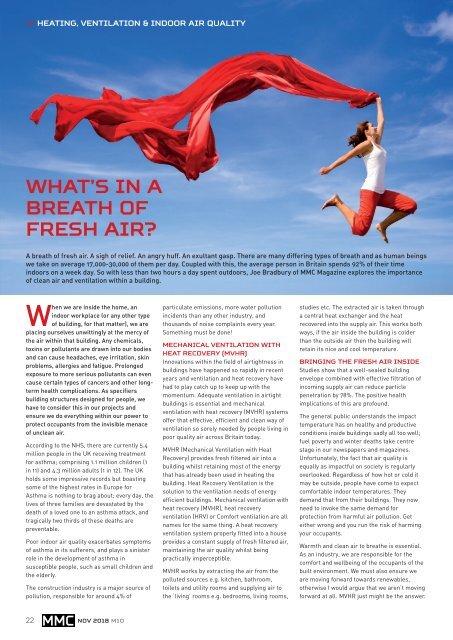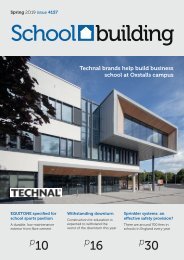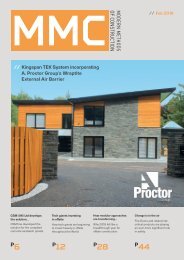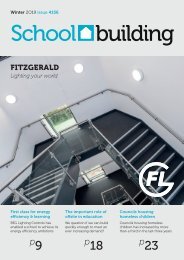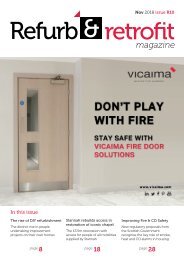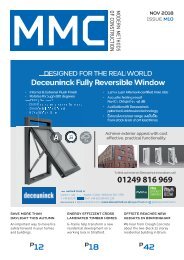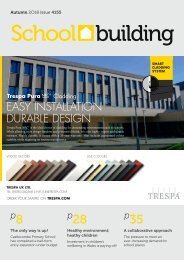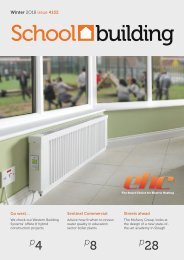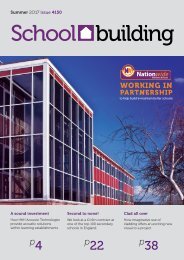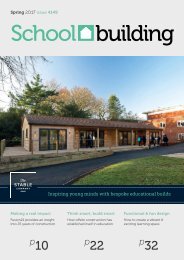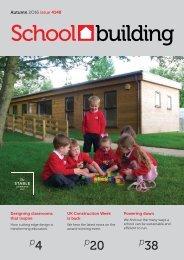You also want an ePaper? Increase the reach of your titles
YUMPU automatically turns print PDFs into web optimized ePapers that Google loves.
Heating, Ventilation & Indoor Air Quality<br />
What’s in a<br />
breath of<br />
fresh air?<br />
A breath of fresh air. A sigh of relief. An angry huff. An exultant gasp. There are many differing types of breath and as human beings<br />
we take on average 17,000-30,000 of them per day. Coupled with this, the average person in Britain spends 92% of their time<br />
indoors on a week day. So with less than two hours a day spent outdoors, Joe Bradbury of <strong>MMC</strong> Magazine explores the importance<br />
of clean air and ventilation within a building.<br />
When we are inside the home, an<br />
indoor workplace (or any other type<br />
of building, for that matter), we are<br />
placing ourselves unwittingly at the mercy of<br />
the air within that building. Any chemicals,<br />
toxins or pollutants are drawn into our bodies<br />
and can cause headaches, eye irritation, skin<br />
problems, allergies and fatigue. Prolonged<br />
exposure to more serious pollutants can even<br />
cause certain types of cancers and other longterm<br />
health complications. As specifiers<br />
building structures designed for people, we<br />
have to consider this in our projects and<br />
ensure we do everything within our power to<br />
protect occupants from the invisible menace<br />
of unclean air.<br />
According to the NHS, there are currently 5.4<br />
million people in the UK receiving treatment<br />
for asthma; comprising 1.1 million children (1<br />
in 11) and 4.3 million adults (1 in 12). The UK<br />
holds some impressive records but boasting<br />
some of the highest rates in Europe for<br />
Asthma is nothing to brag about; every day, the<br />
lives of three families are devastated by the<br />
death of a loved one to an asthma attack, and<br />
tragically two thirds of these deaths are<br />
preventable.<br />
Poor indoor air quality exacerbates symptoms<br />
of asthma in its sufferers, and plays a sinister<br />
role in the development of asthma in<br />
susceptible people, such as small children and<br />
the elderly.<br />
The construction industry is a major source of<br />
pollution, responsible for around 4% of<br />
22 <strong>MMC</strong><br />
Nov 2018 <strong>M10</strong><br />
particulate emissions, more water pollution<br />
incidents than any other industry, and<br />
thousands of noise complaints every year.<br />
Something must be done!<br />
Mechanical Ventilation with<br />
Heat Recovery (MVHR)<br />
Innovations within the field of airtightness in<br />
buildings have happened so rapidly in recent<br />
years and ventilation and heat recovery have<br />
had to play catch up to keep up with the<br />
momentum. Adequate ventilation in airtight<br />
buildings is essential and mechanical<br />
ventilation with heat recovery (MVHR) systems<br />
offer that effective, efficient and clean way of<br />
ventilation so sorely needed by people living in<br />
poor quality air across Britain today.<br />
MVHR (Mechanical Ventilation with Heat<br />
Recovery) provides fresh filtered air into a<br />
building whilst retaining most of the energy<br />
that has already been used in heating the<br />
building. Heat Recovery Ventilation is the<br />
solution to the ventilation needs of energy<br />
efficient buildings. Mechanical ventilation with<br />
heat recovery (MVHR), heat recovery<br />
ventilation (HRV) or Comfort ventilation are all<br />
names for the same thing. A heat recovery<br />
ventilation system properly fitted into a house<br />
provides a constant supply of fresh filtered air,<br />
maintaining the air quality whilst being<br />
practically imperceptible.<br />
MVHR works by extracting the air from the<br />
polluted sources e.g. kitchen, bathroom,<br />
toilets and utility rooms and supplying air to<br />
the ‘living’ rooms e.g. bedrooms, living rooms,<br />
studies etc. The extracted air is taken through<br />
a central heat exchanger and the heat<br />
recovered into the supply air. This works both<br />
ways, if the air inside the building is colder<br />
than the outside air then the building will<br />
retain its nice and cool temperature.<br />
Bringing the fresh air inside<br />
Studies show that a well-sealed building<br />
envelope combined with effective filtration of<br />
incoming supply air can reduce particle<br />
penetration by 78%. The positive health<br />
implications of this are profound.<br />
The general public understands the impact<br />
temperature has on healthy and productive<br />
conditions inside buildings sadly all too well;<br />
fuel poverty and winter deaths take centre<br />
stage in our newspapers and magazines.<br />
Unfortunately, the fact that air quality is<br />
equally as impactful on society is regularly<br />
overlooked. Regardless of how hot or cold it<br />
may be outside, people have come to expect<br />
comfortable indoor temperatures. They<br />
demand that from their buildings. They now<br />
need to invoke the same demand for<br />
protection from harmful air pollution. Get<br />
either wrong and you run the risk of harming<br />
your occupants.<br />
Warmth and clean air to breathe is essential.<br />
As an industry, we are responsible for the<br />
comfort and wellbeing of the occupants of the<br />
built environment. We must also ensure we<br />
are moving forward towards renewables,<br />
otherwise I would argue that we aren’t moving<br />
forward at all. MVHR just might be the answer.


